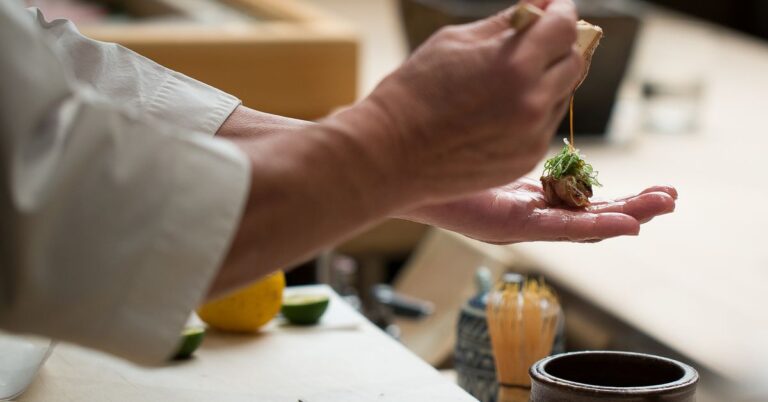Food Tarot Decks Are Having a Moment. ‘Divine Your Dinner’ Makes It a Meal.
The cards told me I should have a cocktail first. It was dinnertime, I was starving, and the idea of my empty stomach being full of a vodka slushie went against all of my instincts. But this is what Divine Your Dinner, the new cookbook from Courtney McBroom and Melinda Lee Holm, asked me to do. I had to trust in the magic.
Most of the time, one’s cooking is done based on the question, “What do I want to eat?” There are secondary considerations — budget, seasonality, and availability of ingredients — but if you’re cracking open a cookbook, your primary motivation is figuring out what it is you’re in the mood for. But Divine Your Dinner suggests you let your meal be guided by the magic of the tarot deck; the book assigns recipes to each of the 78 cards of the modern tarot, and there are two ways to use the book — cook a recipe aligned with whatever card’s energy you wish to embody, or pull a card or three and make whatever the fates have decided.
I figured, as someone who has been practicing tarot on and off since she was a teen, the best way to engage with the book is to leave my meal up to the cards. Maybe they would reveal something more than just what I should eat.
:no_upscale()/cdn.vox-cdn.com/uploads/chorus_asset/file/22955625/tarot_dyp.jpg)
“Kitchen magick” (the “k” is often used to distinguish the supernatural from, like, Penn & Teller) is an umbrella term for the practice of injecting magic into what would otherwise be the chore of cooking. In her book Kitchen Witchery, Laurel Woodward describes kitchen magick as the “most functional form of magick,” and the kitchen witch as someone who uses “everyday items to brew potions, make teas, and cook up tasty treats for those she loves,” using “the magickal properties of herbs, spices, vegetables, fruits, roots and greens to empower her workings.” It’s a pretty straightforward idea — the vegetables and meats and herbs in your kitchen each have specific powers, and when combined can embody sort of a spell. After all, when you picture a witch you probably see her at her cauldron, dropping ingredients into a bubbling stew.
Tarot originally began as a card game, and you can see its influences — the four suits, the court cards — in modern playing card decks. But around the 18th century the deck began to be used for divinatory purposes. Each card in the Major Arcana (the trump cards of the deck) and the Minor Arcana (the suited cards) has specific imagery used to evoke different feelings and tropes, which many use to read deeper into questions of life and love. At its most basic, it works by asking the cards a question, which will be answered (or sometimes further complicated) by what you draw. Every tarot reader brings their own interpretations to the cards, but for the most part certain cards mean certain things: The Devil could represent vices that you know are bad but you can’t tear yourself away from. The Queen of Swords could be a woman in your life who is compassionate but also brutally honest. The Ten of Wands is what it looks like when you’re so overwhelmed with obligations you’re about to crash. It’s then your job to interpret what this means based on what you were trying to know.
Divine Your Dinner is the latest work to combine tarot with kitchen magick. So far, culinary tarot offerings (yes, it is a genre now) have been mostly about education. Decks like the Tadka Tarot, the Herbal and Spiced Culinary Tarot, and the Pasta Tarot work either as informational tools or broader suggestions to intuit what you might want to cook. The Pasta Tarot, for instance, offers both vibes and specific shapes of pasta with each card, but not recipes. The Tadka Tarot shows you how to pair vegetables with South Asian spices, but says nothing of spirituality. You might be inspired to go to the farmers market after pulling The Farmer from the Herbal and Spiced deck, but it won’t tell you what to make.
Divine Your Dinner works with the Rider-Waite-Smith deck, maybe the most recognizable tarot deck, whose images have relatively long-standing, accepted interpretations. The book suggests a dish for each card based on ingredients assigned to each suit (i.e. seafood for cups, grains for pentacles) of the Minor Arcana, and for the Major Arcana with “ingredients emblematic of the wisdom of each card.” You could be making bagna cauda to represent the lesson about overcoming scarcity from the Five of Pentacles, or a lavender celebration spritz for The Tower, where lavender is said to calm you when all the structures of your life seem to be tumbling down.
My life was not tumbling down. Not yet. But I had been feeling for weeks a vague sense of unease, which my therapist would just call my “unspecified anxiety disorder.” Things were going well. I was seeing friends and family and getting to write about tarot for work and spend most evenings with my loving spouse. I was happy, right? But no matter how I tried, I could not trust that instinct. Every time I settled into happiness a voice intruded, telling me I was wrong, that my loved ones must be lying to me, that any minute my comfort would be revealed as an elaborate prank the world was playing on me. All in all it’s not a fun way to live.
Divine Your Dinner has set menus for when you want to evoke a certain feeling. (For instance, to feel clarity, cook the recipes related to the Wheel of Fortune, the Seven of Swords, and the King of Wands.) But to use the cookbook to its fullest, I decided to cook based on my own tarot reading. I pulled three cards from the This Might Hurt deck, illustrated by Isabella Rotman, one each to represent my current situation, the obstacle, and advice from the universe I should follow. As I shuffled, I asked the cards how to trust what those I love tell me, and how to trust myself. Therapy has helped, but maybe it was time for food to take over.
First, I pulled Strength, which in Divine Your Dinner corresponds to Moscow mule melon slushies. “There are parts of you that are wild and parts of you that try to bring wild aspects of your character under control,” writes Rotman of the card, represented by a woman calming a lion. In this card, Strength is not achieved by force, but by calm, vulnerability, and acceptance of one’s roughest, wildest parts. I immediately saw my current situation — I was failing to achieve this balance. I was trying to will my anxieties into submission. According to the kitchen witches, ginger and mint would help — the mint for perception and the ginger to “support courage and trusting instincts.” Plus, vodka. I had to loosen up.
My obstacle was represented by The Moon, the card of intuition and the unknown, featuring howling wolves and a dark road under a moonlit sky. The Moon often represents something that is hidden from your conscious mind, and I reared for a moment, worrying that this meant my worst paranoias might actually be true. But what’s more likely is that I’m hiding something from myself. I need to face it to see the daylight again. And I need to trust in my ability to do that. The corresponding recipe is pumpkin cornbread, as pumpkin is said to “illuminate inner vision,” and help me face my fears.
Finally, advice to get me out of this mess came with the Ten of Pentacles, a scene of a multigenerational family celebrating and thriving together in abundance. “The community you have helped build is truly supportive of the needs and dreams of all; you are free to begin again,” says Divine Your Dinner. To celebrate, the card instructed me to make a veggie muffuletta, with olives to represent peace, sympathy, and balance. It sounded good, but I wasn’t sure of the advice here. If I knew how to celebrate and thrive in abundance, I would just… do that. I would not be here, asking a cookbook to make me better. But at least the cards led me to a relatively traditional meal; another combination could have led me to three cocktails, or three elaborate cakes. Maybe that meant something.
What I love about tarot is that it’s decidedly not magic. I know this all probably sounded like woo-woo nonsense, but at no point did I feel the cards were in charge. Through the cards, I was telling myself a story, seeing how I reacted to certain images or tropes, and interrogating those reactions. Why did the idea of being kind to this hulking lion make me feel so raw? Why did a warm room full of loved ones feel so distant? I kept these images in mind as I blitzed melon, simmered ginger syrup, and whisked cornmeal with pumpkin puree.
The point of a spell, to me, is not that the olives and mint call up to the high heavens and bless me with special powers. It’s the transformation that comes to you when you pay attention. Measuring ingredients and cooking them in a precise order leaves little room for thinking of anything else, and it doesn’t matter whether that’s eye of newt in a bubbling cauldron or cornmeal and buttermilk in a hot skillet. Chefs and food writers have always waxed about the feeling of being in the kitchen, the world melting away as they practice their craft. Divine Your Dinner just calls it a spell, and who’s to say that’s wrong?
My spouse and I had the cocktails first, and while I’m not sure I’ll be returning to the combination of cantaloupe and ginger, the zap woke me up. I have been guilty of automatically pouring myself a glass of whatever wine is around at the end of the workday to ensure I don’t sit on my laptop until I go to sleep. But a slushie cocktail served in a novelty tiki cup I had to dust off for the occasion (a Tuesday) brought me into the present, and made me aware that I had a choice. I could go through the motions of eating dinner, watching TV while mostly scrolling through my phone, and going to bed before another workday, or I could focus on the sensations of the meal and the whole night. This is not all that different from other nights when I decide to cook something more elaborate instead of making a frittata with whatever leftovers are in the fridge, but there was something about not deciding that changed the nature of my attention. I was doing this, but I wasn’t quite in charge. I could observe. I could be present.
As I sipped my cocktail while finishing up the last touches of dinner, I felt my spouse entwine their arms around my waist. I leaned back into them, as I smelled the faintest hint of pumpkin emanating from the cooling cornbread. I felt warm and relaxed, and thought of my obstacle — feeling confused in the dark, and the pumpkin’s supposed ability to illuminate the way. I focused on my partner’s arms, their body behind me, and the smile in their voice as they marveled at the cornbread. I was feeling some sense of light.
We first ate the cornbread, made incredibly moist but not at all sweet by the pumpkin. Then came the muffuletta, with a relish of giardiniera, peperoncini, and olives. I omitted the olives for my partner, who hates them, and worried briefly and illogically that it would somehow mean whatever spell I was invoking wouldn’t work. But the pickled tang of the relish, the creamy mozzarella, and the crunchy cucumbers made for an incredible sandwich, which I had previously associated only with the luxury of vacations to New Orleans.
I watched them enjoy it, feeling the joy that comes from feeding someone. Like the Ten of Pentacles predicted, by reaching out and sharing with my community (even if it’s just my spouse), I felt abundance in return. We spent the rest of the night on the couch, watching a movie together, animatedly dissecting it afterward, engaging with each other on a first cozy fall night. And because I had made the choice to pay attention, I saw that things were pretty great.
The meal didn’t cure my anxiety. In the days since I’ve still had moments of worry, moments where I acted out of fear, and racing thoughts. But I can think back to the story I told myself with those dishes — how I had a hard time letting go of my anxiety, but once I made the choice to, I saw that everything was okay on the other side. If I can follow that path once, I can do it again. That’s all magic is.






